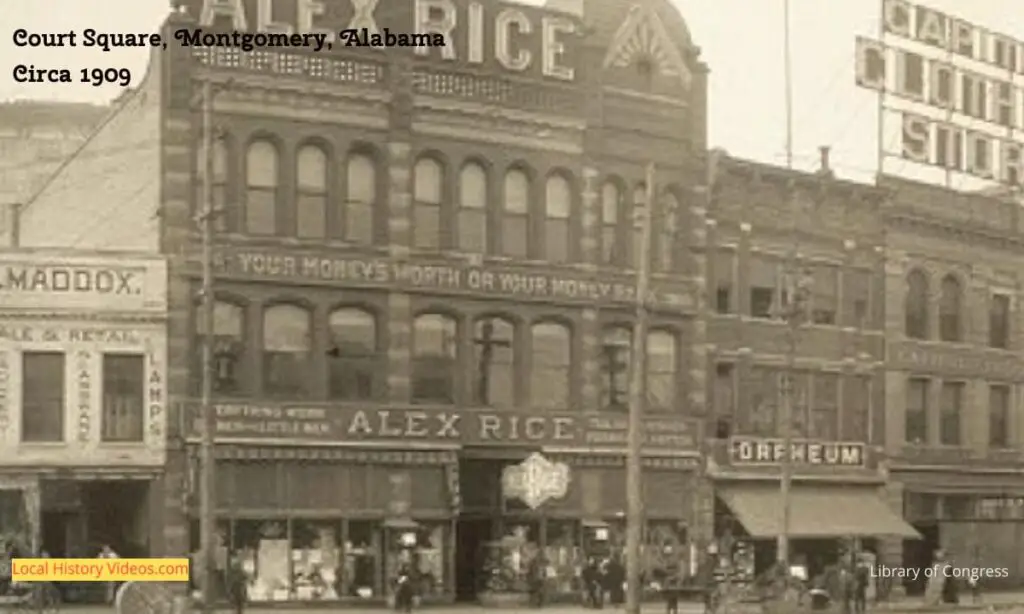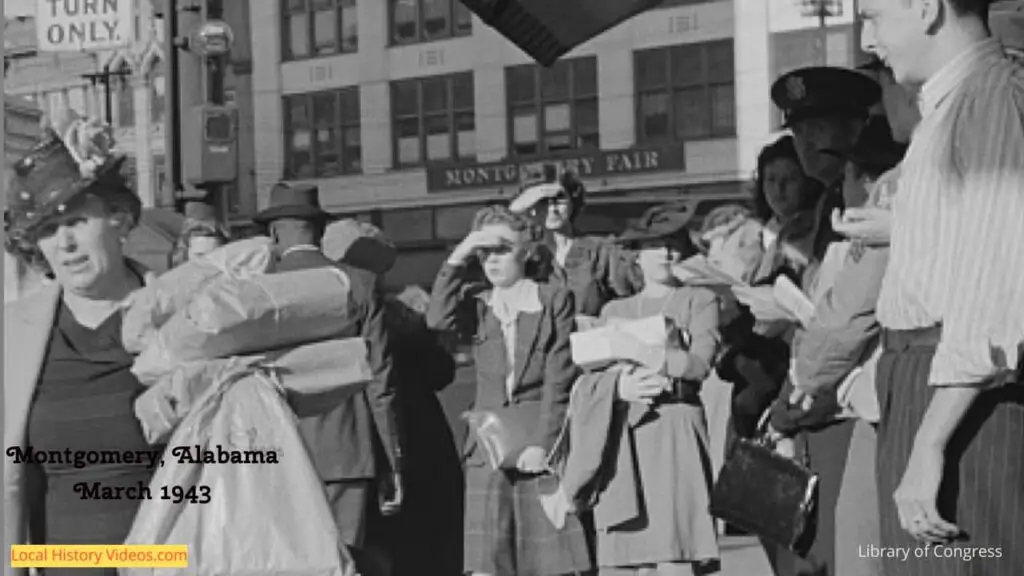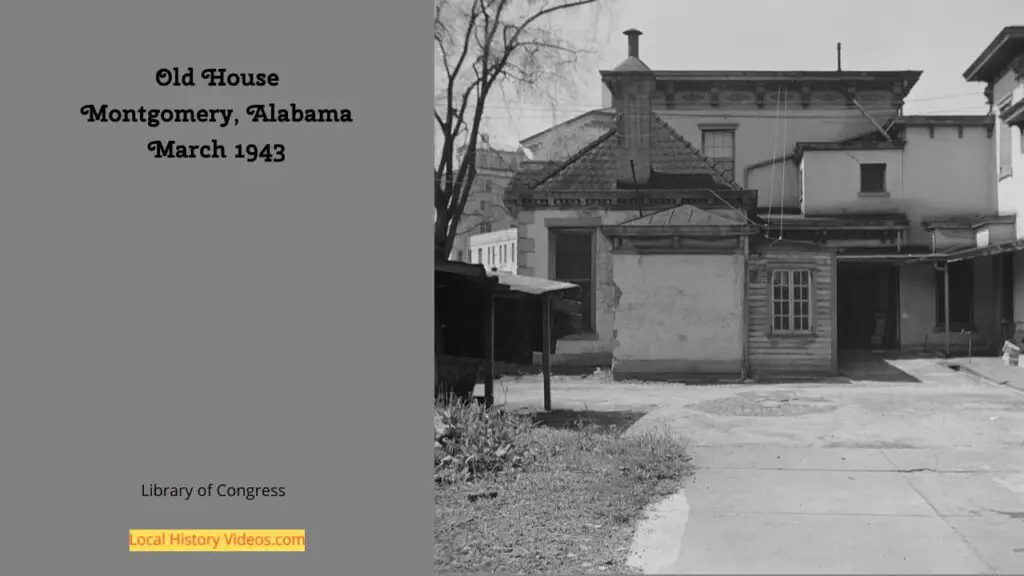Glimpse history through old images of Montgomery , Alabama, in the United States of America.
Od Photos of Montgomery, Alabama























































































Montgomery, Ala in the 1930s & 40s




















































European Arrival in Montgomery
When Hernando de Soto and his expedition team camped at Towessa for a week in 1540, they were the first documented Europeans in the area. There wasn’t another white expedition near here until 1697, when a group from Carolina went down the Alabama River.
But Native Americans had long lived there. The Alibamu tribe inhabited the left bank of the Alabama River, while the Alibamu and Coushatta inhabited the right bank.
In 1716, Scottish trader James McQueen arrived, and became the Montgomery area’s first permanent settler, but it would be almost a century before more settlers arrived in large numbers.
A year later, Fort Toulouse was built by the French, with its primary aim to trade with the Alibamu community. Following the French and Indian War in 1764, all French and Spanish possessions east of the Mississippi River transferred to the British.
Alabama’s area was divided between the Indian Reserve and British West Florida in 1767, with the boundary line running just north of where Montgomery lies today.
The Province above the boundary later became part of the US State of Georgia, with the United States government owning the land following the 1783 Treaty of Paris at the end of the American Revolutionary War. But in another treaty Spain received West Florida, and it was not until 1795 that the United States received the southern half of Montgomery as part of a territory agreement in the Treaty of San Lorenzo.
In 1785 a Pennsylvanian man called Abraham Mordecai settled in the area. He would later bring in the area’s first cotton gin.
Removal of the Native Americans
The Creek War ended in August 1814, with the United States gaining most of the Native American lands. Many of the native communities who had populated the banks of the Alabama River for centuries now moved south.
Creation of Montgomery County
Sometime between 1814 and 1816, a cabin was built by Arthur Moore, close to the site where today you’ll find Union Station.
Montgomery County was formed in 1816. It was named in memory of Major Lemuel P. Montgomery, who died at the Battle of Horseshoe Bend during the Creek War. Note that the city of Montgomery is named after a different military leader with that family name.
In 1817, the federal land office in Milledgeville, Georgia, sold the land lots for Montgomery County.
Who founded Montgomery Alabama?
General John Scott led the first group of settlers to the county, and they established Alabama Town. The following year, the county courts were moved to Alabama Town, having previously been in Fort Jackson.
Nearby, and not long after, the town of New Philadelphia was founded by Andrew Dexter, Jr. He named a hilltop ‘Goat Hill’ and allocated it as the site of a future state capitol building, which did in fact happen 29 years later.
With New Philadelphia growing well, Dexter and his associates built East Alabama Town adjacent to New Philadelphia.
When was Montgomery Alabama founded?
The city of Montgomery was founded on December 3, 1819. It merged Dexter’s two towns, New Philadelphia and East Alabama Town, into one incorporated city.
In today’s downtown Montgomery, streets to the east of Court Street are aligned in a north-south and east-west grid. Streets to the west of Court Street are aligned parallel and perpendicular to the Alabama River. This is a lasting legacy of Montgomery’s roots in two different towns.
How did Montgomery Alabama get its name?
The city of Montgomery was named after General Richard Montgomery. He had died in the American Revolutionary War, during a military offensive to capture Quebec City in Canada.
A Period of Growth
The cotton trade fueled Montgomery’s early growth.
- October 1821, the steamboat Harriet began a route along the Alabama River between Montgomery and Mobile
- 1822, Montgomery became a county seat
- 1822, a new courthouse built (now Court Square)
- April 1825, Marquis de Lafayette’s grand tour of the United States included a visit to Montgomery
- 1832, Montgomery Railroad opened
- 1851, Montgomery Railroad reached West Point, Georgia
- January 28, 1846, state capital moved from Tuscaloosa to Montgomery
- 1847, State Capitol building completed
- December 1, 1849, State Capitol building burned down
- 1851 State Capitol rebuild completed


American Civil War (1861–65)
William Lowndes Yancy, serving in both houses of the Alabama State Legislature and in the U.S. House of Representatives, a ‘Fire-Eater’ leader of the Southern secession movement and defender of slavery, was a Montgomery resident.
Representatives from Alabama, Georgia, Florida, Louisiana, Mississippi, and South Carolina met in Montgomery to form the Confederate States of America, naming Montgomer the first capital of the nation.
On February 18, 1861, on the steps of Montgomery’s State Capitol, Jefferson Davis was inaugurated president of the Confederacy.

The Exchange Hotel near Court Square was used for Confederate government activities. On April 11, 1861, an order to fire on Fort Sumner was sent from the telegraph office of the Winter Building. That incident began the American Civil War.
Montgomery was almost untouched by the resulting conflict, as the capital moved to Richmond in Virginia on May 29, 1861, to be nearer the military campaign. But following the Battle of Selma, Montgomery was captured by Major General James H. Wilson on April 12, 1865.
Yancey had already died at that point, succumbing to long term illness on July 1863, aged 48.
Montgomery’s Transport Revolution
In 1886, the citywide electric streetcar system, nicknamed the Lightning Route, was installed in Montgomery. It was the first city in the United States to have this mode of transport, and soon led to the boom in suburbs as workers could now travel further from home on a daily basis.
The Wright brothers opened the Wright Flying School in Montgomery on March 19, 1910, and developed several airfields.
When the Wright brothers began working with the government to produce planes for military use, one of their airfields developed into the Maxwell-Gunter Air Force Base.
Red Summer 1919
Three African Americans were murdered in September 1919, which was a year of white supremacist terrorism and racial riots (by both black and white communities) known as Red Summer.
Miles Phifer and Robert Crosky were gunned down, having been pulled from a police transportation vehicle by 25 masked men. A few hours later, in a separate incident, John Temple was lynched in a hospital.
Montgomery Advertiser 1937
About 100,000 people lived in Alabama’s state capital city when this film clip was recorded in 1937.
Young Jo is being dropped off outside the Montgomery Advertiser by his mother and aunt on a Saturday morning, so he can do some work for his project at school.
Montgomery, AL 1937 – Alabama Pioneers on YouTube
Merci Boxcar 1949
49 boxcars, built in France between 1852 and 1885, originally used for shipping freight, and animal livestock and then for transporting troops during the two wars, were chosen for the Merci Boxcar gifts.
They were filled with tens of thousands of gifts from French citizens to the American troops who, as part of the Allied forces, had liberated France from the Nazis.
In February 1949, the Merci Boxcars arrived aboard the Magellanin at the Weehawhen docks, New Jersey.
5,114 soldiers from Alabama lost their lives during service in World War II.
Montgomery turned out with pride and remembrance in February 1949 to officially receive one of the Merci Boxcars, accompanied by a military parade.
You can see the real Merci Boxcart at the museum in Huntsville, Alabama.
Merci Boxcar arriving in Montgomery, Alabama circa 1949 – Wil Elrick on YouTube
What civil rights movement happened in Montgomery Alabama in 1955?
The now-famous Montgomery bus boycott was sparked in December 1955, when Rosa Parks was arrested for refusing to move to the ‘colored’ section of the bus to vacate the seat in the ‘white’ section of the bus for a white passenger. The boycott lasted a year, and ultimately led to the Supreme Court upholding a 1965 court ruling that Montgomery’s bus segregation system was illegal.
Martin Luther King, Jr, the pastor of the Dexter Avenue Baptist Church, was one of the Montgomery bus boycott organisers. He led the founding of the Southern Christian Leadership Conference, and left Montgomery in 1960 to continue leadership in the civil rights movement.
Cilvil Rights Movement in Montgomery 1960
In 1960, a sit-in at the lunch counter in the State Capitol was organised by students from Alabama State College. Governor John Malcolm Patterson had them expelled, at which point thousands of students marched on the Capitol.
Then on May 20, 1961, the Freedom Riders arrived in Montgomery, travelling from Birmingham Alabama on inter-state buses.
They had met with violence in Anniston and Birmingham, with mobs reacting to the groups’ testing of inter-state bus segregation laws.
Montgomery city police ignored Governor Patterson’s pledge to protect the Freedom Riders arriving in the city. Instead, they allowed a mob to attack both the Freedom Riders and those Justice Department officials attempting to stop the violence. Then the Freedom Riders were served injunctions for inciting violence.

Dr King’s Speech 1965
In March 1965, Dr King gave a speech to 25,000 people outside the Capitol.
It was a key moment during a civil rights march from Selma to Montgomer to petition Governor George to overturn the Jim Crow laws which blocked the right of black people to register to vote.
Dale’s Penthouse Fire 1967
In 1967, a customer at the restaurant and lounge of Dale’s Penthouse, on the top floor of the Walter Bragg Smith apartment building, placed a pipe in his coat pocket, without having checked it was fully extinguished.
One of the people killed by the resulting fire was former Alabama Public Service Commissioner Ed Pepper. Earlier that day, he had been indicted by a Federal Grand Jury. His wife Ann also died in the fire.
In total, the fire at Dale’s Penthouse caused the death of 26 people.
Historic Montgomery
Old Photos of Montgomery (Alabama)1906-1918 – oldstuff4all on YouTube
More about Alabama
- Labor Rights in Old Birmingham, AlabamaThe labor movement in Birmingham, Alabama, has been a significant part of the city’s industrial history, characterized by a struggle for workers’ rights, labor organization, and social justice.
- Birmingham, Alabama in the 1930sStep back in time to 1930s Birmingham, Alabama, a vibrant city struggling with the impact of the Great Depresssion.
- Birmingham, Alabama in 1926By 1926, Birmingham, Ala., was at the height of its industrialization and a dynamic, modern place to be.
- The Finley Roundhouse at Birmingham, AlabamaThe Finley Roundhouse was an important part of railway history in Birmingham, Alabama. Abandoned and derelict, its roof was destroyed by a hurricane.
- Company Housing in Old Birmingham, AlabamaAs workers migrated into the expanding city of Birmingham, Alabama the company houses were in high demand.
- Making Concrete in Old Birmingham, AlabamaConcrete was an essential part of growing the city and industries of Birmingham, Alabama.
- The Steel Industry in Birmingham, AlabamaDiscover why steel was such an important part of the local economy in Birmingham, Alabama, USA.
- Old Photos of the Workers of Mobile, AlabamaGlimpse history through old photos of adults and children at work in Mobile, Alabama, USA.
- The Child Workers of Birmingham, AlabamaDiscover the haunting old photos of children who worked in the factories, eateries, messaging and transportation industries of Birmingham, Alabama.
- Old Images of Mobile, AlabamaGlimpse history through old images of Mobile, in Alabama, USA.











